ARMANDS
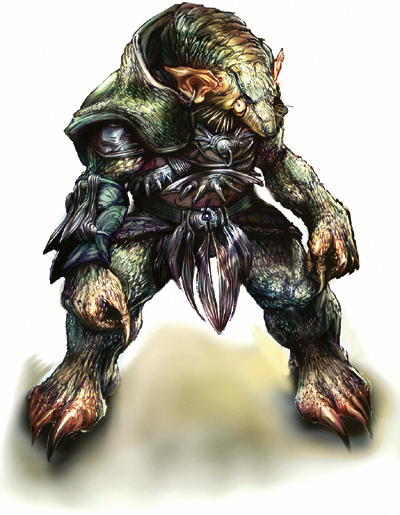
Armands are nomadic humanoids who wander the desert in search of new experiences. They operate as a democratic unit with all adult armands able to voice and vote in council. They don't believe in individual ownership and share all possessions and resources among other armands. Their philosophy scorns wealth because of its transitory nature. Of infinitely greater value are experiences, and those armands who have traveled, adventured, and returned to the tribe are deemed "wise ones" whose advice carries the most weight. Thus, many young adult armands leave their families and seek to see more of the world.
An armand prefers to avoid combat. It enjoys living and treasures new experiences. An armand rarely starts a conflict because combat too often causes an untimely end and deprives the armand or its foe of the pleasures of life. However, it will certainly fight if attacked.
Armand leaders arise from those who have traveled widely and experienced much. It is the duty of an armand warden to return to the tribe and lend its wisdom to the group. An armand tribe usually consists of several small, closely knit family groups that come together to share resources. When faced with a deadly common foe, many tribes will converge on a defensible location to "make their stand." Tribes look to the wardens for leadership, and a single tribe may have several wardens leading it. The armands rarely build permanent dwellings. They live in large communal tents or take advantage of ready shelter, such as caves.
Armands worship Fharlanghn, Obad-Hai, or Pelor (or other deities whose portfolios include travel, nature, and the sun).
A typical armand stands 3-1/2 to 4 feet tall and weighs roughly 150 pounds.
ARMAND RACIAL TRAITS
-
+6 Dexterity, +6 Constitution.
-
Small size. +1 bonus to Armor Class, +1 bonus on attack rolls, +4 bonus on Hide checks, -4 penalty on grapple checks, lifting and carrying limits 3/4 those of Medium characters.
-
An armand's base land speed is 20 feet, and it has a burrow speed of 10 feet.
-
Darkvision out to 60 feet.
-
Racial Hit Dice: An armand begins with five levels of monstrous humanoid, which provide 5d8 Hit Dice, a base attack bonus of +5, and base saving throw bonuses of Fort +1, Ref +4, and Will +4.
-
Racial Skills: An armand's monstrous humanoid levels give it skill points equal to 8 × (2 + Int modifier, minimum 1). Its class skills are Jump, Listen, Spot, and Survival. It has a +4 racial bonus on Survival checks.
-
Racial Feats: An armand's monstrous humanoid levels give it two feats.
-
+4 natural armor bonus.
-
Natural Weapons: 2 claws (1d4).
-
Defensive Stance (Ex): When it needs to, an armand can become a stalwart bastion of defense. As a move action, an armand can take a defensive stance, gaining phenomenal precision and durability, but it cannot move while in this stance. The creature gains a +2 bonus on attack rolls, a +2 resistance bonus on all saves, and a +4 dodge bonus to AC until it moves.
-
Stability (Ex): Armands are exceptionally stable on their feet. They gain a +4 bonus on ability checks made to resist being bull rushed or tripped when standing on the ground or burrowing (but not when climbing, flying, riding, or otherwise not standing firmly on the ground).
-
Automatic Languages: Common and Armandish. Bonus Languages: Elven, Giant, Gnome, Goblin, Sylvan.
-
Favored Class: Monk.
-
Level adjustment +3.
CHANGELINGS
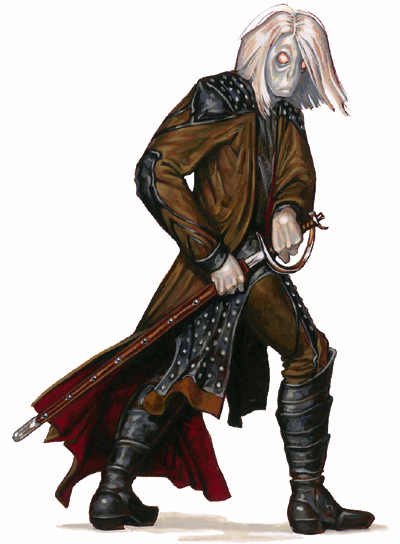
Changelings are subtle shapeshifters capable of disguising their appearance. They evolved through the union of doppelgangers and humans, eventually becoming a separate race distinct from either ancestral tree. Changelings do not possess the full shapechanging ability of doppelgangers, but they can create effective disguises at will. This ability makes them consummate spies and criminals, and many changelings live up to that potential.
In general, changelings are prudent and cautious, preferring to take risks only when they feel that their chances are good or the payoff is worth it. They appreciate the finer things in life and take great pleasure in the comforts of a wealthy lifestyle when they can obtain it. They avoid direct confrontation, preferring stealthy strikes and hasty retreats whenever possible. In conversation, they are soft-spoken but have a gift for drawing out more information than the other party usually plans to reveal.
Changelings strongly resemble their doppelganger lineage, with only a passing nod to their humanoid heritage. All changelings fall within the boundaries of Medium size, usually standing between 5 and 6 feet tall. Unlike true doppelgangers, changelings do have gender in their natural form, although they can adopt any shape they like. They speak Common, but many changelings enjoy collecting other languages to expand their repertoire of disguises and identities.
Humans and elves regard changelings with suspicion. Many, however, have reason to do business with them. Dwarves have little patience for their deceptive and subtle manner. Gnomes and halflings, on the other hand, enjoy matching wits with changelings, though they are often rivals in certain shady activities.
Changelings do not build cities of their own, but live among humans, goblinoids, or other races, blending in among them and living in their shadow. They are most commonly found in large cities, where they form the backbone of the criminal underworld, though many find more respectable work as entertainers, government agents, and sometimes adventurers. Even in large cities, they do not cluster into extremely large groups. A changeling "clan" is actually a voluntary association of changelings grouped together for mutual protection rather than a group of blood relatives. Clan heads govern by the consent of the clan, and this position tends to change hands frequently. Bosses maintain order and help organize the clan for common purposes. A changeling clan includes 30% noncombatants, primarily children and the elderly, who are usually the primary reason for the clan's existence. Changelings without dependents generally find little reason to associate with a clan and operate alone or in smaller gangs organized by a charismatic leader.
Many changelings revere the deity known as the Traveler. Many others follow a personal philosophy of the perfect form, in which physical transformation is a spiritual practice symbolizing purification. This philosophy is curiously amoral, and its practitioners include both assassins and saintly ascetics.
Changelings are reluctant fighters, preferring to intimidate or bluff their opponents. When forced to fight, they fight defensively while assessing their chances of winning the fight. Changelings are not above running when they find themselves in a losing situation.
CHANGELING RACIAL TRAITS
-
Humanoid (Shapechanger).
-
Medium size.
-
Changeling base land speed is 30 feet.
-
+2 racial bonus on saving throws against sleep and charm effects.
-
Minor Change Shape (Su): Changelings have the supernatural ability to alter their appearance as though using a disguise self spell that affects their bodies but not their possessions. This is not an illusory effect but a minor physical alteration of a changeling's facial features, skin color and texture, and size, within the limits described for the spell. A changeling can use this ability at will, and the alteration lasts until she changes shape again. A changeling reverts to her natural form when killed. A true seeing spell reveals her natural form. Using this ability is a full-round action. When using its minor change shape ability, a changeling gets a +10 circumstance bonus on Disguise checks.
-
+2 racial bonus on Bluff, Intimidate, and Sense Motive checks.
-
Natural Linguist: Changelings add Speak Language to their list of class skills for any class they adopt.
-
Automatic Languages: Common. Bonus Languages: Auran, Dwarven, Elven, Giant, Gnome, Halfling, and Terran.
-
Favored Class: Rogue.
DRACOTAURS
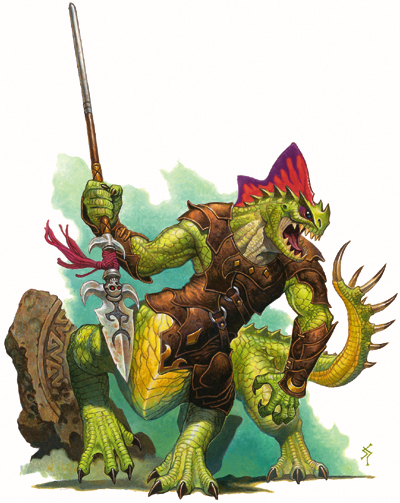
Dracotaurs are sly, merciless predators incapable of showing compassion and expecting none in return.
Hard scales that vary in color from green to brown cover a dracotaur from head to tail. Males have ornate cresting on their heads, throats, and chests ranging from bright red to deep purple. A dracotaur's 4-footlong tail, although used primarily for balance, ends in wicked spikes that can be brought to bear in battle. Dracotaurs excrete body oil that helps keep their scales and leather armor supple. They typically wield sharp spears.
Dracotaurs overwhelm their foes quickly using ambushes and flanking tactics. Cold, calculating creatures, dracotaurs usually announce their presence by spitting gouts of fire at their foes and then charge forward with their spears. In the unfolding conflict, a dracotaur relies on its brute strength and multiple attacks to win the day.
Dracotaurs gather in small, nomadic tribes. Dracotaurs respect power above all, and they measure power in terms of raw strength and arcane magical ability. Their leaders are usually mighty warriors, sorcerers, or both. Although dracotaur tribes occasionally fight over land, rival tribes quickly band together when faced with a common outside threat. Dracotaurs will also ally with other reptilian creatures, including lizardfolk and nagas. Although they are not devout creatures, dracotaurs see true dragons as powerful embodiments of the ancient gods and will give their lives in the service of such creatures. Much of the race's arcane knowledge comes from the ancient teachings of the true dragons.
Dracotaurs rarely stay in any one place long enough to warrant the building of permanent settlements. However, tribes will often lay claim to ancient ruins and use them as sanctuaries, training grounds, or neutral meeting places. Dracotaurs and centaurs despise one another, and many a dracotaur warrior dreams of devouring the flesh of a fallen centaur foe.
An adult dracotaur stands 7 feet tall and measures 10 feet long, weighing about 2,000 pounds. Dracotaur clerics (which are rare) worship Tiamat and can choose from the Destruction, Evil, and Trickery domains.
DRACOTAUR RACIAL TRAITS
-
+8 Strength, +2 Dexterity, +6 Constitution, +2 Intelligence, +2 Charisma.
-
Large size: -1 penalty to Armor Class, -1 penalty on attack rolls, -4 penalty on Hide checks, +4 bonus on grapple checks, lifting and carrying limits double those of Medium characters.
-
Space/Reach: 10 feet/5 feet.
-
A dracotaur's base land speed is 50 feet.
-
Darkvision out to 60 feet, low-light vision.
-
Racial Hit Dice: A dracotaur begins with three levels of dragon, which provide 3d12 Hit Dice, a base attack bonus of +3, and base saving throw bonuses of Fort +3, Ref +3, and Will +3.
-
Racial Skills: A dracotaur's dragon levels give it skill points equal to 6 × (6 + Int modifier). Its class skills are Intimidate, Jump, Knowledge (arcana), Listen, Sense Motive, Spellcraft, Spot, Survival, Swim, and Use Magic Device. Because of their tails, dracotaurs have a +4 racial bonus on Balance, Jump, and Swim checks.
-
Racial Feats: A dracotaur's Hit Dice give it two feats.
-
Weapon and Armor Proficiency: Proficient with all simple weapons. Proficient with light armor.
-
+5 natural armor bonus.
-
Natural Weapons: Bite (1d8) and tail slap (1d8 plus 1 1/2 Strength bonus).
-
Spit Fire (Su): A dracotaur can spit a glob of fire as a standard action. Once a dracotaur spits, it cannot spit again for 1 minute. The dracotaur's spittle is a sticky adhesive substance that ignites when exposed to air, much like alchemist's fire. This glob of fiery spittle is treated as a ranged touch attack with a range increment of 20 feet. A direct hit deals 2d6 points of fire damage. Every creature within 5 feet of the point where the spittle hits takes 1d4 points of fire damage from the splash. Unlike alchemist's fire, a dracotaur's spittle does not continue to burn.
-
Immunity to magic sleep effects and paralysis.
-
Automatic Languages: Draconic. Bonus Languages: Any.
-
Favored Class: Sorcerer.
-
Level adjustment +5.
SAND GIANTS
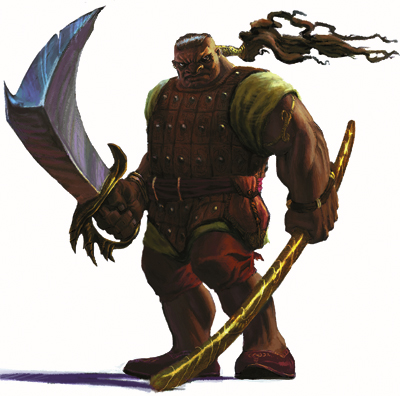
Disciplined and cautious, sand giants are respected, honorable desert-dwellers.
A sand giant's hair can be black, brown, tan, or blond, and its eyes usually match its hair color. Its skin ranges from a deep chocolate brown to pale beige. Sand giants prefer loose, light garments in colors that harmonize with their desert landscape, such as sandy beige, white, dusty red, and khaki. They avoid wearing bulky or metal armor, preferring leather or studded leather in the hot desert.
Sand giants live in stable communities in the desert. Their lives revolve around ordered discipline. Their desert dwellings exhibit careful organization and a layout that emphasizes defensibility. They often build into the side of a mesa or in some other geographically sheltered area.
Sand giant leadership originates from a hereditary monarchy. The next king or queen is the first-born child of the present monarch. A complicated line of succession based on blood relations and birth order dictates the order of the heirs beyond the first. Most sand giant communities are isolated in the desert, but the giants are by no means isolationists. They usually conduct profitable trades with caravans and travelers. Occasionally, a sand giant will act as a guide for travelers in the harsh desert.
A sand giant usually prepares for combat by digging into the sand and hiding to lure its opponents in close, readying its sand blaster to spray its enemies. In close com bat, a sand giant wields its mighty scimitar.An adult male is about 12 feet tall and weighs about 2,000 pounds. Females are slightly larger and heavier, but otherwise identical with males. Sand giants can live to be 250 years old.
SAND GIANT RACIAL TRAITS
-
+16 Strength, +10 Dexterity, +10 Constitution, +6 Wisdom, +2 Charisma.
-
Large size. -1 penalty to Armor Class, -1 penalty on attack rolls, -4 penalty on Hide checks, +4 bonus on grapple checks, lifting and carrying limits double those of Medium characters.
-
A sand giant's base land speed is 40 feet, and it has a burrow speed of 10 feet.
-
Low-light vision.
-
Racial Hit Dice: A sand giant begins with fifteen levels of giant, which provide 15d8 Hit Dice, a base attack bonus of +11, and base saving throw bonuses of Fort +9, Ref +5, and Will +5.
-
Racial Skills: A sand giant's giant levels give it skill points equal to 18 × (2 + Int modifier, minimum 1). Its class skills are Hide, Knowledge (nature), Listen, Spot, and Survival. A sand giant gains a +8 racial bonus on Hide checks and Survival checks in deserts.
-
Racial Feats: A sand giant's giant levels give it six feats.
-
Weapon Familiarity: Sand giants treat sand blasters as martial weapons rather than exotic weapons.
-
+11 natural armor bonus.
-
Spell-Like Abilities: 1/day - meld into stone, statue. Caster level 15th.
-
Heat Shimmer (Su): At will as a free action, a sand giant can create a shimmering effect around itself that functions like a blur spell, caster level 15th.
-
Fire Subtype: Immunity to fire, vulnerability to cold.
-
Automatic Languages: Common and Giant. Bonus Languages: Draconic, Elven, Goblin, Orc.
-
Favored Class: Fighter.
-
Level adjustment +4.
FLINDS
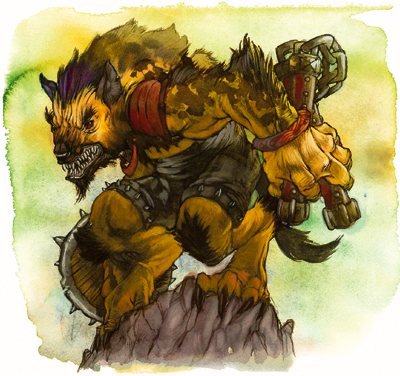
These powerful and merciless relatives of the gnolls are often found in gnoll bands as leaders or elite hunters. While gnolls admire and respect them, flinds have no great love for their lesser cousins.
The merciless flinds are clever tacticians, preferring to use surprise, terrain, and superior numbers to their advantage. When commanding gnoll hunting parties, they have no qualms about sacrificing their cousins for personal gain.
A flind appear much like a gnoll, though it is a little shorter and broader. It stands roughly 7 feet tall and weighs 300 to 350 pounds. A flind's forehead does not slope back as far, and its ears are more rounded than those of an ordinary gnoll. Flind leaders are usually rangers or blackguards. Flind clerics typically worship Erythnul, deity of slaughter.
FLIND RACIAL TRAITS
-
+6 Strength, +2 Dexterity, +4 Constitution.
-
Medium size.
-
A flind's base land speed is 30 feet.
-
Darkvision out to 60 feet.
-
Racial Hit Dice: A flind begins with two levels of humanoid, which provide 2d8 Hit Dice, a base attack bonus of +1, and base saving throw bonuses of Fort +3, Ref +0, and Will +0.
-
Racial Skills: A flind's humanoid levels give it skill points equal to 5 × (2 + Int modifier, minimum 1). Its class skills are Listen and Spot. Flinds gain a +2 racial bonus on Charisma-based checks made to influence gnolls.
-
Racial Feats: A flind's humanoid levels give it one feat.
-
Weapon Familiarity: Flinds treat flindbars as martial weapons rather than exotic weapons.
-
+2 natural armor bonus.
-
Automatic Languages: Common, Gnoll. Bonus Languages: Draconic, Elven, Goblin, Orc.
-
Favored Class: Ranger.
-
Level adjustment +2.
GOATFOLK
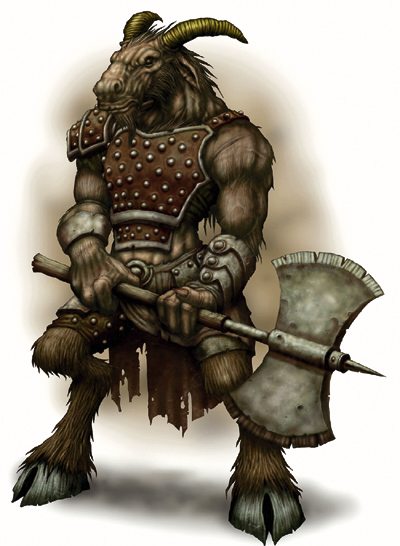
Goatfolk are powerfully built goatlike creatures that resemble satyrs. Unlike their hedonistic and mischievous fey cousins, goatfolk are much more physically focused creatures who favor a barbarian lifestyle.
Goatfolk choose leaders by combat, and the strongest and most aggressive lead the pack. Thus, leadership is transitory and prone to challenge. Both males and females assert themselves and hold these temporary positions of power.
These creatures call themselves ibixians, and races that deal regularly with them use the proper name, but colloquially, they've been dubbed "goatfolk."
Goatfolk enjoy melee combat. They often start fights for the sheer pleasure of fighting.
Goatfolk are bigger than most humans and almost all satyrs, standing about 6 to 6-1/2 feet tall and weighing about 250 pounds.
GOATFOLK RACIAL TRAITS
-
+4 Strength, +2 Constitution, -2 Intelligence, -2 Wisdom.
-
Medium size.
-
An ibixian's base land speed is 30 feet.
-
Darkvision out to 60 feet.
-
Racial Hit Dice: An ibixian begins with three levels of monstrous humanoid, which provide 3d8 Hit Dice, a base attack bonus of +3, and base saving throw bonuses of Fort +1, Ref +3 and Will +3.
-
Racial Skills: An ibixian's monstrous humanoid levels give it skill points equal to 6 × (2 + Int modifier, minimum 1). Its class skills are Intimidate, Listen, Spot, and Survival. It has a +4 racial bonus on Intimidate checks.
-
Racial Feats: An ibixian's monstrous humanoid levels give it two feats.
-
Weapon Proficiency: An ibixian is proficient with the greataxe and all simple weapons.
-
+2 natural armor bonus.
-
Natural Weapons: Head butt (1d6).
-
Pack Fervor (Ex): An ibixian loves to brawl with or alongside others of its kind. Doing this increases its enjoyment of the fight and adds ferocity to its attacks. When an ibixian is within 30 feet of another goatfolk, it gains a +2 morale bonus on attack rolls and damage rolls and a +4 morale bonus on saving throws against fear effects.
-
Automatic Languages: Ibixian and Common. Bonus Languages: Elven, Giant, Gnome, Goblin, Sylvan.
-
Favored Class: Barbarian.
-
Level adjustment +1.
FORESTKITH GOBLINS
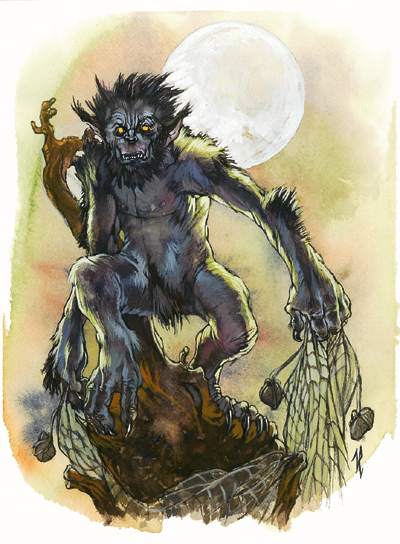
These nocturnal hunters, also known as kith, are formidable despite their small size. Though they can easily stand upright, forestkith goblins tend to run and walk on all fours in a manner characteristic of primates, perhaps because their arms are longer than their legs. Their mouths sport very sharp teeth, and each hand and foot brandishes long, curved claws adapted for climbing. They spend most of their time in trees.
Forestkith goblins hunt most creatures that travel through their forest territories, ignoring only those creatures larger than a horse. In lean times, forestkith goblins often plan and execute sophisticated raids on humanoid frontier communities for food, preferring snatch-and-run tactics targeting the young.
Forestkith goblins excel at ambushes and use well-established tactics to fit the prey they seek. If fighting a larger group, they attack the weakest members with nets first, dragging the entangled victims away quickly to feed on them before going back for the rest.
Forestkith goblins attack obviously superior foes heedlessly with the same wild frenzy and loud, discordant screams that paralyze their weaker foes with fright. Their lust for the kill usually overwhelms concern for individual safety. Any attack on a more numerous, stronger, or more sophisticated foe can result in the whole forestkith goblin party being wiped out if it is not led by a druid kith elder, who alone possesses the wisdom and leadership to order a strategic retreat.
Forestkith goblins do not have a sophisticated culture or written language. The only tools they routinely make are their nets, which are highly prized by hunters for their masterwork quality.
Forestkith goblins are nomadic hunters and have no established home, but roam a well-defined territory, usually 5 square miles per group member. Forestkith goblins hunt until the rays of daylight make their way through the forest canopy, whereupon they immediately go to sleep in their tree shape wherever they are standing.
They operate with a semblance of pack unity and coordination only when executing ambushes or raids for food. Forestkith goblins encountered alone are usually social outcasts. Political currency in forestkith goblin society is defined only by who can guarantee the most food. Leaders can be either male or female, determined by who can devise and orchestrate the most lethal ambushes and raids as well as personally lead the charge.
A forestkith goblin stands about 3 feet tall and weighs about 40 pounds.
FORESTKITH GOBLIN RACIAL TRAITS
-
+2 Dexterity, -2 Intelligence.
-
Small size. +1 bonus to Armor Class, +1 bonus on attack rolls, +4 bonus on Hide checks, -4 penalty on grapple checks, lifting and carrying limits 3/4 those of Medium characters.
-
A forestkith goblin's base land speed is 30 feet.
-
Darkvision out to 60 feet.
-
Racial Skills: +2 racial bonus on Jump checks. They also have a +8 racial bonus on Climb checks and can always choose to take 10 on Climb checks, even if rushed or threatened. Forestkith goblins gain a +4 racial bonus on Hide and Move Silently checks in forested areas. They gain a +4 racial bonus on Craft (weaving) checks to create nets.
-
Weapon Familiarity. Forestkith goblins treat nets as martial weapons rather than as exotic weapons.
-
+1 natural armor bonus.
-
Discordant Frenzy (Ex): When melee ensues, forestkith goblins go into a frenzy, jumping about chaotically and screaming loudly. Creatures with 2 HD or fewer within 30 feet of at least three attacking forestkith goblins become shaken for 1d4 rounds unless they succeed on a Will save. A creature that resists the effect cannot be affected by it for 24 hours. This is a mind-affecting fear effect. The save DC is Charisma-based.
-
Light Sensitivity (Ex): Forestkith goblins are dazzled in bright sunlight or within the radius of a daylight spell.
-
Tree Shape (Su): A forestkith goblin can change form into a small tree, shrub, or limb, equivalent to the tree shape spell as cast by a 12th-level druid. A forestkith goblin typically uses this ability at or near daybreak as a form of camouflage, due to its dislike for daylight. A goblin cannot dismiss this effect, but it ends automatically at sunset or if the goblin takes damage.
-
Automatic Languages: Goblin. Bonus Languages: Common, Elven, Giant, Orc.
-
Favored Class: Barbarian.
-
Level adjustment +1.
HARSSAFS

As harsh and unyielding as their desert homes, harssafs don't typically deal congenially with others. Harssafs live in and wander the great deserts and barren places of the world. Seemingly composed of the fire and sand of their home terrain, they live in nomadic bands and frequently raid settlements within or near their desert homes.
Harssafs live mostly insular lives, traveling and raiding throughout a massive section of desert. Harssafs have no compunctions about killing when necessary, but they take no particular pride in it. Killing to the harssafs is a necessary skill to survive the coming sandstorms that will carry the great desert to the far reaches of the world.
A harssaf prefers to ambush its opponents, hiding among the dunes near the desert edge in sand form or just beneath the sands and using its blindsense to determine when potential targets wander by. Once engaged in melee, a harssaf ignites its weapons and closes to melee, wielding its twin kukris with deadly efficiency. Most clans of harssafs include monks that specialize in the arts of grappling, and one of these can frequently be found as part of a raiding party. These individuals have the unenviable job of subduing spellcasters, especially those that exhibit any signs of casting cold magic.
Harssaf clans are incredibly structured, composed of a strict caste system of scouts and tenders. Tenders comprise less than one-third of a band's total population, and even they are capable warriors. Consisting mostly of scouts incapable of fighting due to age or infirmity, pregnant females, young children, and the few craftsfolk of the clan, tenders are regarded as second-class citizens. Leaders of the clans always emerge from the scout caste, which consists of any male or female of fighting age.
Males and females have an equal opportunity to prove themselves worthy of the scout caste. But females who have children are relegated to be tenders until their children are old enough to be left with others of the caste. Only then can these females return to the scout clan. As a result, children are raised by the clan as a whole, being alternately schooled by different members of the scout caste. These scouts have taken it upon themselves to educate the youngsters in various martial and religious mysteries to ensure they are prepared to choose their career when they come of age.
Harssaf clans sometimes skirmish over resources or territory, but they prefer to avoid fighting other chosen desert dwellers and focus their raids on the soft outlanders. A harssaf camp is usually composed of several small tents shared by tenders, and a few large pavilions where the scouts stay. Due to their natural affinity for hot and sandy environments, harssafs have no problem sleeping in the open desert. Rumors exist of ancient harssaf structures in the deepest deserts, strongholds that all clans visit from time to time. These strongholds are said to hold the history of the mysterious harssaf people, as well as monasteries that devote themselves to schooling the many monks of the harssaf clans.
Harssafs worship no particular deity, but rather worship the desert itself. They believe their race once spawned from the desert, and that one day the desert will rise up to swallow the earth in its warm embrace. Only they, the faithfully prepared, will survive the onslaught of the desert. A few worship powerful lords of the Elemental Plane of Fire.
Both male and female harssafs stand about 6 feet tall and weigh about 190 pounds. Harssaf clerics can choose from the Fire, Law, Strength, and Sun domains.
HARSSAF RACIAL TRAITS
-
+4 Strength, +6 Dexterity, +6 Constitution, +2 Charisma.
-
Medium size.
-
A harssaf's base land speed is 30 feet, and it has a burrow speed of 10 feet.
-
Racial Hit Dice: A harssaf begins with six levels of monstrous humanoid, which provide 6d8 Hit Dice, a base attack bonus of +6, and base saving throw bonuses of Fort +2, Ref +5, and Will +5.
-
Racial Skills: A harssaf's monstrous humanoid levels give it skill points equal to 9 × (2 + Int modifier, minimum 1). Its class skills are Climb, Hide, Jump, Knowledge (nature), Listen, Move Silently, and Spot.
-
Racial Feats: A harssaf's monstrous humanoid levels give it three feats. It also has Alertness and Lightning Reflexes as bonus feats.
-
+3 natural armor bonus.
-
Flaming Aura (Su): At will as a free action, a harssaf can generate an intense fiery heat. This aura takes the form of a miragelike shimmering around a harssaf's body. Any creature that comes within 5 feet of a harssaf automatically takes 1d6 points of fire damage per round, and any creature struck by a harssaf's melee attacks takes an extra 1d6 points of fire damage. Only metallic weapons conduct this heat, but harssafs rarely wield wooden weapons when they use this ability, since doing so typically renders the weapons useless after a few rounds.
-
Sand Pulse (Su): Once per day as a standard action, a harssaf can generate a sand pulse in a 30-foot-radius spread centered on itself. All creatures within the area must make a DC 15 Reflex save or take 3d6 points of damage from the high-powered blast of sand and be blinded for 5 rounds. Success negates the blindness and halves the damage. The save DC is Constitution-based.
Creatures that do not rely on eyes to see (such as grimlocks) are unaffected by the blindness but can still take damage from the sand pulse. Harssafs are immune to the sand pulses of other harssafs.
-
Sand Form (Su): At will as a standard action, a harssaf can assume the form of a pile of mobile sand. This ability works as the gaseous form spell, except the harssaf is composed of sand instead of vapor and it cannot fly; harssafs in sand form slither along the ground and can fit through gaps or crevices less than one-quarter inch wide.
-
Blindsense 30 ft.
-
Damage reduction 5/bludgeoning.
-
Fast healing 3.
-
Immunity to blindness.
-
Fire Subtype: Immunity to fire, vulnerability to cold.
-
Spell resistance equal to 17 + class levels.
-
Automatic Languages: Common, Ignan. Bonus Languages: Draconic, Dwarven, Elven, Giant, Halfling, Orc, Terran.
-
Favored Class: Monk.
-
Level adjustment +4.
KENKUS
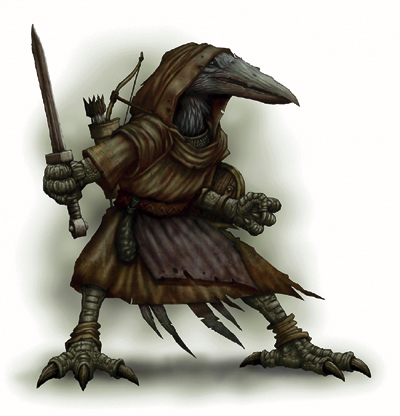
Kenkus evolved from avians, although they no longer possess wings or the ability to fly. Soft, dark feathers cover a kenku's head and torso, although its scrawny arms and legs remain bare.
Selfish and secretive in their dealings, kenkus gather in large cities, lurk in dark alleys, and hoard purloined gold. They rarely travel alone, instead preferring to roam the streets in small gangs, all the while hatching plots to amass more wealth and power. Due to their penchant for shady ventures, they are often employed as thugs, thieves, spies, and assassins.
Beneath their unremarkable brown robes, kenkus conceal a variety of useful tools and weapons. Vicious but cowardly, kenkus usually flee or surrender the instant things start to go badly for them.
Kenkus hatch like birds and dwell in family aeries and nests, most of which are located in or near large cities. At age nine, a young adult kenku leaves the home-nest forever and strikes out on its own, usually falling in with small groups of like-minded kenkus. Adult kenkus remain with these groups for mutual protection and gain. A few strike out on their own or partner with other types of creatures who value the services a kenku can provide.
Kenku characters tend toward neutrality; although most kenkus are evil, neutral and neutral good kenkus also exist. Kenkus favor the rogue class and often pursue the assassin prestige class. Kenku clerics are rare, but those that exist typically worship Vecna, the god of secrets.
A kenku averages 5 feet in height. Because its bones are partly hollow, it weighs a mere 75 pounds.
KENKU RACIAL TRAITS
-
+2 Dexterity, -2 Strength.
-
Medium size.
-
A kenku's base land speed is 30 feet.
-
Low-light vision.
-
Great Ally (Ex): Kenkus work exceptionally well with their allies. When successfully aided on a skill check or attack roll by an ally, or when aiding another, a kenku applies or gains a +3 bonus on its check or attack roll (instead of the normal +2 bonus). Furthermore, a kenku gains a +4 bonus on attack rolls against an opponent flanked by an ally (instead of the normal +2 bonus).
-
Mimicry (Ex): A kenku can perfectly mimic familiar sounds, voices, and accents. This ability does not enable the kenku to speak languages it can't normally speak. To duplicate a specific individual's voice, a kenku makes a Bluff check; a listener familiar with the voice being imitated must succeed on an opposed Sense Motive check to discern that the voice isn't genuine.
-
Natural Weapons: 2 claws (1d3).
-
+2 racial bonus on Hide checks and Move Silently checks.
-
Automatic Languages: Common and Kenku. Bonus Languages: Auran, Dwarven, Gnome, Goblin, Halfling.
-
Favored Class: Rogue.
BLACKSCALE LIZARDFOLK
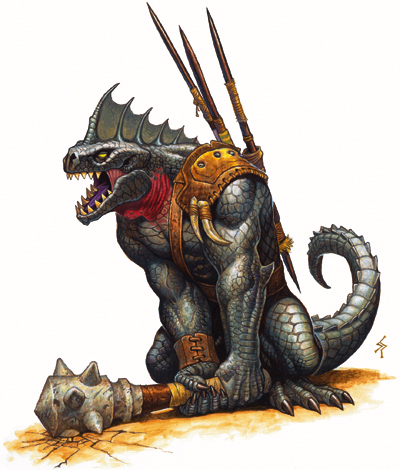
Like their smaller cousins, blackscale lizard folk are primitive reptilian humanoids that can be very dangerous if provoked.
Blackscale lizardfolk are proud and fierce fighters, concerned with heroic action and personal glory. Left on their own, they will fight as disorganized individuals, but their leaders can force them to work together for short periods of time. The blackscales have little patience for tricks and traps, considering such tools to be the trade of lesser lizardfolk.
Blackscales claim that their dark coloration and facial features are proof of a blood connection to the dragons of Haka'torvhak, but little proof to this claim exists.
The jungles of Q'barra are home to three distinct species of lizardfolk - the blackscales, the Cold Sun Tribes, and the poison dusk. The blackscales are the largest of the three, and throughout the history they have used their size to dominate and intimidate their smaller kindred. They are the guardians of the sacred city of Haka'torvhak and the warriors of the dragon Rhashaak. They are proud and arrogant, and are usually extremely hostile toward humans who trespass into the deep jungles of Q'barra.
While their culture is quite primitive, the black scales have access to the vaults and arsenals of Haka'torvhak. High-ranking warriors or priests wear glittering jewels, and the weapons of the blackscales are often elaborately carved and decorated. The guardians of the sacred city may be equipped with better weapons, shields, or armor - possibly even magic relics from the deep vaults.
The blackscales typically live off the "tribute" they extract from the other tribes - officially, offerings made to the great dragon and its guardians. The dragon priests hold the ultimate authority within society but rarely use this power; in the absence of interference from a priest, the most powerful warrior rules the tribe. Any of the three species of lizardfolk can be called to serve as dragon priests; the blackscales consider the priests to be a fourth tribe, and thus see no shame in following their commands.
A blackscale lizardfolk is usually 8-1/2 to 9-1/2 feet tall, and weighs about 600 pounds. Its tail is 4 to 5 feet long.
BLACKSCALE LIZADFOLK RACIAL TRAITS
-
+8 Strength, +4 Constitution, -2 Intelligence, -4 Charisma.
-
Large size. -1 penalty to Armor Class, -1 penalty on attack rolls, -4 penalty on Hide checks, +4 bonus on grapple checks, lifting and carrying limits double those of Medium characters.
-
Space/Reach: 10 ft./10 ft.
-
A blackscale lizardfolk's base land speed is 40 feet.
-
Darkvision out to 60 feet.
-
Racial Hit Dice: A blackscale lizardfolk begins with four levels of monstrous humanoid, which provide 4d8 Hit Dice, a base attack bonus of +4, and base saving throw bonuses of Fort +1, Ref +4 and Will +4.
-
Racial Skills: A blackscale lizardfolk's monstrous humanoid levels give it skill points equal to 7 × (2 + Int modifier, minimum 1). Its class skills are Balance, Jump, Spot, and Swim. Because of their tails, blackscale lizardfolk have a +4 racial bonus on Balance, Jump, and Swim checks.
-
Racial Feats: A blackscale lizardfolk's monstrous humanoid levels give it two feats.
-
Weapon Proficiency: A blackscale lizardfolk is proficient with greatclub, javelin, and all simple weapons.
-
+7 natural armor bonus.
-
Natural Weapons: 2 claws (1d6), bite (1d6).
-
Hold Breath (Ex): A blackscale lizardfolk can hold its breath for a number of rounds equal to 4 × its Constitution score before it risks drowning.
-
Resistance to acid 5.
-
Automatic Languages: Draconic. Bonus Languages: Aquan, Common, Goblin, Gnoll, Orc.
-
Favored Class: Barbarian.
-
Level adjustment +3.
POISON DUSK LIZARDFOLK
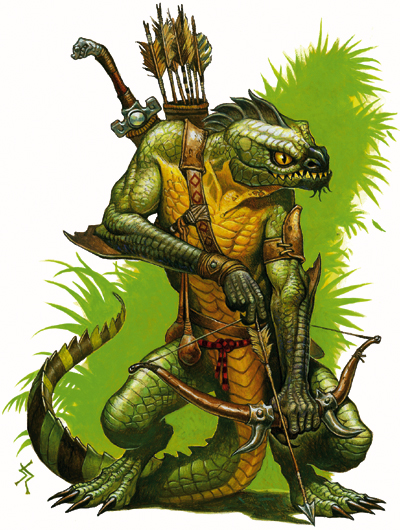
While smaller than their lizardfolk cousins, the poison dusk lizardfolk are just as dangerous when provoked. A poison dusk lizardfolk is between 3 to 4 feet in height, weighing 42-52 pounds. Its tail is 2 to 3 feet long, and its scales shift color with its mood. The eyes of a poison dusk lizardfolk are larger than those of the other species, and males have a crest running down the back of the head that can lie flat or extend based on mood.
Poison dusks are more intelligent and dedicated than the other lizardfolk, and most develop ranger skills. Poison dusk sorcerers and adepts are called by their dragon overlords to serve as dragon priests and are not found among the tribes.
Poison dusks are far more cunning than the other species of lizardfolk. They prefer to avoid physical combat altogether if possible; when striking against a human village, they will often try to poison the water or food supply instead of launching a direct assault. When they do fight, they favor ambushes and clever traps. Bolas and nets are considered to be martial weapons for poison dusks, and they often use these tools to handicap larger foes while archers strike with poisoned arrows.
POISON DUSK LIZARDFOLK RACIAL TRAITS
-
+2 Dexterity, +2 Constitution, -2 Charisma.
-
Small size. +1 bonus to Armor Class, +1 bonus on attack rolls, +4 bonus on Hide checks, -4 penalty on grapple checks, lifting and carrying limits 3/4 those of Medium characters.
-
A poison dusk lizardfolk's base speed is 30 feet.
-
Low-light vision.
-
Poison Use: Due to their long tradition of working with venoms, poison dusks are never at risk when applying poisons to weapons. Common poisons include black adder venom and blue whinnis.
-
Chameleon Skin (Ex): Poison dusks can adjust the colors of their scales to blend in with their surroundings. When it is not wearing armor, robes or other covering clothing, a poison dusk lizardfolk gains a +5 racial bonus on Hide checks.
-
Hold Breath (Ex): A poison dusk lizardfolk can hold its breath for a number of rounds equal to 4 × its Constitution score before it risks drowning.
-
Racial Skills: A poison dusk lizardfolk has a +4 racial bonus on Balance, Jump, and Swim checks.
-
+3 natural armor bonus.
-
Natural Weapons: 2 claws (1d3) and bite (1d3).
-
Weapon Familiarity: Poison dusk lizardfolk treat bolas and nets as martial weapons rather than exotic weapons.
-
Automatic Languages: Draconic, Common. Bonus Languages: Halfling, Sylvan.
-
Favored Class: Ranger. A multiclassed poison dusk's ranger class does not count when determining whether it takes an XP penalty.
-
Level adjustment +1.
LUMI
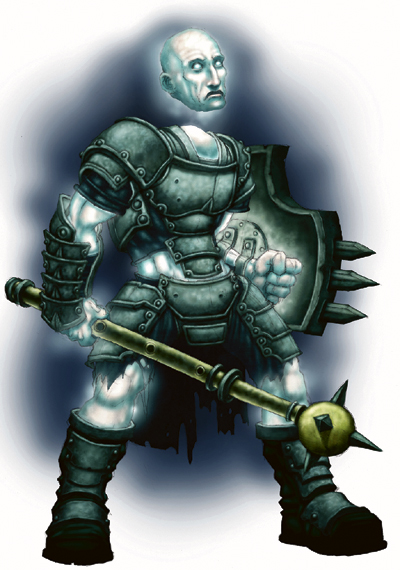
The lumi are a race of warriors and healers who live on the Positive Energy Plane. There they build towering cities of glass and light that are protected from intruders simply by virtue of the plane's dangers to nonnative life. The power of unchecked positive energy keeps all but the most curious from even reaching their doorstep.
The lumi worship Light as a concept rather than owing allegiance to any deity. They praise its ability to uncover that which is hidden and see it as a symbol of purity and truth. The lumi themselves are honest to a fault and are known for their inability to hold back from telling others blunt and unflattering truths. They despise deception above all other offenses, and lies (or even simple illusion spells) are capital crimes within their settlements. Lumi often travel to the Material Plane to battle wielders of negative energy or known deceivers. This can make them allies of good-aligned adventurers for a time, but they put their own code of honesty and truth ahead of the well-being of others. They think nothing of slaying those who offend their morality.
The lumi have a highly ordered society with a strict hierarchy based on their theology. Each settlement is more or less independent, though periodically the High Ecclesiastics of many cities will gather in a hidden cathedral that floats alone in the Positive Energy Plane.
The lumi are dedicated to wiping out liars and other deceivers; they would like nothing more than to invade the Material Plane and execute every dishonest creature. Fortunately, their numbers are far too few for such a scourge - so far. The lumi's numbers are growing quickly. Some worry that within less than twenty years, the lumi may have enough soldiers to enact their envisioned cleansing. Such an invasion is likely to have grave consequences.
A lumi wields a golden morningstar with trained ease as it wades into melee. It prefers open combat on a clear field of battle, eschewing ambush tactics entirely. Lumi clerics favor spells that enhance their warriors over those that directly affect the enemy.
An average lumi stands between 5 and 7 feet in height and weighs 100 to 300 pounds. A lumi cleric worships Light and can choose from the Law, Sun, and War domains.
LUMI RACIAL TRAITS
-
+2 Strength, +4 Constitution, +4 Wisdom, -2 Dexterity.
-
Medium size.
-
A lumi's base land speed is 30 feet.
-
Darkvision out to 60 feet.
-
Racial Hit Dice: A lumi begins with two levels of outsider, which provide 2d8 Hit Dice, a base attack bonus of +2, and base saving throw bonuses of Fort +3, Ref +3, and Will +3.
-
Racial Skills: A lumi's outsider levels give it skill points equal to 5 × (8 + Int modifier). Its class skills are Concentration, Diplomacy, Heal, Knowledge (the planes), Listen, Search, Sense Motive, and Spot. Lumi have a +2 racial bonus on Search, Sense Motive, and Spot checks.
-
Racial Feats: A lumi's outsider levels give it one feat. It gains Improved Initiative as a bonus feat.
-
Spell-Like Abilities: At will - disrupt undead, light; 3/day - cure light wounds, glitterdust. Caster level 3rd.
-
Body of Light (Su): A lumi's body is infused with a softly glowing positive energy. It is immune to all death spells, magical death effects, energy drain, and any negative energy effects (such as from inflict spells or chill touch).
Lumi are adapted to live on the Positive Energy Plane. They never gain additional temporary hit points as a result of being on a plane with the major positive-dominant energy trait, and thus are never in danger of exploding when on the Positive Energy Plane. They still gain full benefit from the fast healing ability of planes with any positive-energy trait.
A lumi sheds white light in a 5-foot radius at all times. It cannot voluntarily suppress this ability, though the light can be concealed by spells that create darkness.
-
Clear Vision (Ex): A lumi cannot be blinded or dazzled by any effect. It can still be effectively blind due to concealment, such as by darkness or fog. It is specifically immune to color spray, rainbow pattern, searing light, sunbeam, sunburst, or other effects that use direct light as an attack form (such as a ghaele's light ray attack). Sun blades deal only nonlethal damage to a lumi.
-
Floating Head (Ex): A lumi's head naturally floats a few inches above its shoulders. The creature can rotate its head in any direction but cannot raise, lower, or otherwise move its head away from where it floats; an unseen force prevents others from moving its head as well. Opponents who flank a lumi do not gain the normal +2 bonus on attack rolls. Lumi are immune to the decapitation power of a vorpal weapon. They may not be strangled and are immune to suffocation.
-
Automatic Languages: Common, Lumi. Bonus Languages: Abyssal, Celestial, Dwarven, Infernal.
-
Favored Class: Cleric. All lumi clerics channel positive energy regardless of their alignment.
-
Level adjustment +2.
NYCTERS
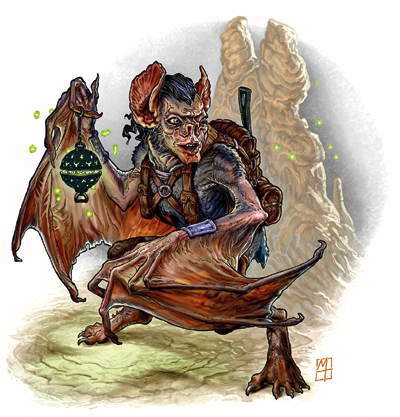
Nycters are cave-dwelling batfolk that strive to live peaceably and well. Distantly related to the desmodus, they view their larger cousins as barbaric savages, akin to the way many humans view ogres. Likewise, desmodus view nycters as lesser beings, simple folk not as brainy or ambitious as their own race.
Nycter culture and society revolve around the cave and the community. Nycters have a keen sense of duty to their group and do their utmost to contribute to it. Nycters prefer peace over war. If they encounter other creatures without being noticed in turn, they often choose to avoid them altogether. If confronted, they parlay and seek harmonious solutions. However, they fight fiercely to defend themselves or their territory.
A nycter stands 2 to 2-1/2 feet tall and weighs 20 to 25 pounds. The creatures' wing colors range from pale tan to dark gray, and the fur tones are tan, brown, or gray.
NYCTER RACIAL TRAITS
-
+4 Dexterity, -2 Strength, +2 Wisdom, -2 Charisma.
-
Small size. +1 bonus to Armor Class, +1 bonus on attack rolls, +4 bonus on Hide checks, -4 penalty on grapple checks, lifting and carrying limits 3/4 those of Medium characters.
-
A nycter's base land speed is 20 feet. It has a fly speed of 40 feet with good maneuverability.
-
Blindsense: A nycter uses echolocation to pinpoint creatures within 60 feet. Opponents still have total concealment against the nycter unless it can actually see them.
-
Darkvision out to 60 feet.
-
Racial Hit Dice: A nycter begins with three levels of monstrous humanoid, which provide 3d8 Hit Dice, a base attack bonus of +3, and base saving throw bonuses of Fort +1, Ref +3, and Will +3.
-
Racial Skills: A nycter's monstrous humanoid levels give it skill points equal to 6 × (2 + Int modifier, minimum 1). Its class skills are Craft, Listen, Spot, and Survival. Nycters have a +4 racial bonus on Spot and Listen checks. These bonuses are lost if their blindsense is negated.
-
Racial Feats: A nycter's monstrous humanoid levels give it two feats.
-
+3 natural armor bonus.
-
Hunting Cry (Su): A nycter can emit a high, piercing shriek that damages and paralyzes its prey (30-foot cone, once every 2d4 rounds, damage 2d4 sonic plus paralysis for 1d4+1 rounds, a Fortitude save halves damage and negates paralysis). This is a sonic mind-affecting ability. A creature that successfully saves cannot be affected again by the same nycter's hunting cry for 24 hours. The save DC is Constitution-based.
-
Vulnerability to sonic.
-
Automatic Languages: Nycter. Bonus Languages: Common, Draconic, Dwarven, Giant, Goblin, Orc.
-
Favored Class: Druid.
-
Level adjustment +2.
SKULLCRUSHER OGRES
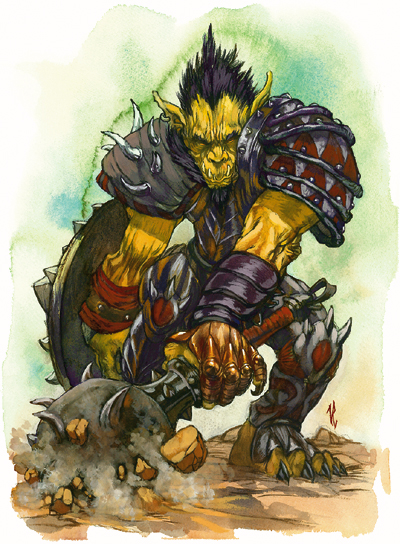
Skullcrusher ogres are an offshoot of the ogre stock bred for war. Shorter and less brutish than typical ogres, skullcrusher ogres are nevertheless stronger and more dangerous. Thuggish and sadistic, bellicose and rowdy, skullcrusher ogres enjoy bullying weaker creatures. Tribes often keep slaves, which in many cases are normal ogres.
Created long ago to serve as soldiers, skullcrusher ogres have naturally centered their culture on warfare, and their villages are arrayed like military encampments. Skullcrusher ogres build siege walls and other structures to defend their homes, and they train elephants for mounted combat.
Skullcrusher ogres are born fighters. They love the clangor and calamity of battle. A skullcrusher ogre gleefully charges into combat and strikes at foes with both its morningstar and spiked shield. A skullcrusher ogre especially enjoys grappling foes and crushing them on his spiked armor.
Although they are as ill-tempered as their ogre brethren, skullcrusher ogres understand the importance of discipline within their fighting squads. The warband becomes their family, of sorts. Their swords and shields become their trusted companions. While lesser ogres allow fatigue, hunger, and petty greed to get the better of them, skullcrushers tirelessly rehearse battle tactics, sharpen their blades, and survey the terrain of the lands they intend to conquer, looking for tactically advantageous ground on which to fight.
A strict hierarchy governs each skullcrusher warband. The smartest and mightiest skullcrusher leads the warband until the day he falls in battle, at which point his chosen successor takes command, often claiming the weapons and trophies of her fallen predecessor. A skullcrusher must fight for her place in the chain of command, and all challenges among members of the warband are resolved through nonlethal combat.
Although incapable of feeling deep love for a comrade-in-arms, a skullcrusher knows better than to take the life of an ally and wouldn't think to deprive another skullcrusher of the chance to die a glorious death on the battlefield.
An adult skullcrusher ogre stands 8 to 9 feet tall and weighs 550 to 600 pounds. The creatures' skin color ranges from pale yellow to pale brown, and their hair tends to be black. Skullcrusher ogres wear armor during their waking hours and little clothing when sleeping.
SKULLCRUSHER OGRE RACIAL TRAITS
-
+14 Strength, +6 Constitution, -2 Charisma.
-
Large size. -1 penalty to Armor Class, -1 penalty on attack rolls, -4 penalty on Hide checks, +4 bonus on grapple checks, lifting and carrying limits double those of Medium characters.
-
Space/Reach: 10 ft./10 ft.
-
A skullcrusher ogre's base land speed is 40 feet.
-
Darkvision out to 60 feet and low-light vision.
-
Racial Hit Dice: A skullcrusher ogre begins with eight levels of giant, which provide 8d8 Hit Dice, a base attack bonus of +6, and base saving throw bonuses of Fort +6, Ref +2, and Will +2.
-
Racial Skills: A skullcrusher ogre's giant levels give it skill points equal to 11 × (2 + Int modifier, minimum 1). Its class skills are Craft, Handle Animal, Intimidate, Knowledge (architecture), and Ride.
-
Racial Feats: A skullcrusher ogre's giant levels give it three feats. A skullcrusher ogre has Improved Grapple and Two-Weapon Fighting as bonus feats.
-
Weapon and Armor Proficiency: A skullcrusher ogre is automatically proficient with simple weapons, martial weapons, all armor, and shields.
-
+2 natural armor bonus.
-
Rock Throwing (Ex): Like giants, skullcrusher ogres are accomplished rock throwers and gain a +1 racial bonus on attack rolls when throwing rocks. A skullcrusher ogre can hurl rocks of 40 to 50 pounds (Small objects) up to five range increments. The range increment is 100 feet for a skullcrusher ogre's rocks.
-
Automatic Languages: Common, Giant. Bonus Languages: Dwarven, Orc, Goblin, Terran.
-
Favored Class: Fighter.
-
Level Adjustment +3.
QUARAPHONS
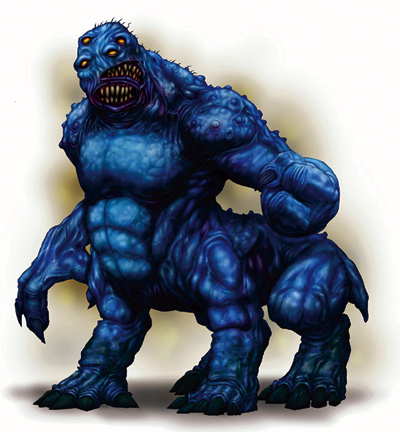
Quaraphons are belligerent, swaggering creatures that wander the open plains looking to hone their fighting prowess on anything that seems to be a challenge. Quaraphons spend most of their time wandering in nomadic groups, hunting herds of large, dangerous animals such as bison and elephants. Because the creatures require a huge amount of food, the range of a quaraphon herd can be enormous and often infringes on the territory of other plains-dwelling races. Most times, these territorial intrusions turn violent, although occasionally the members of a herd will temper their brawling nature to trade with others.
While rather dim, quaraphons love weapons and armor of all kinds and will attack anyone that enters their territory bearing such items. A quaraphon is an unsubtle combatant that relies on its brute strength to discourage any serious resistance. It first lets loose a deafening bellow before charging in on its victim.
Quaraphons live in nomadic herds that roam the open plains and hilly expanses. Most herds have between 30 and 100 individuals, with at least half being females and children. Although omnivorous, quaraphons prefer meat, and the males spend most of their time tracking large game, while females graze for nuts, berries, and tubers to supplement their diet. Constantly on the move, quaraphons travel light and prefer not to burden themselves with large amounts of material goods.
The leader of a quaraphon herd is known as the bullmaster and is always the largest and strongest member. The bullmaster spends most of his time watching out for younger quaraphons that vie for his lofty position. The bellows of dueling quaraphons can be heard for miles around, lending a chilling quality to the desolate plains. However, while males are definitely in charge of the tribes, elder females also have a serious say in matters - a bullmaster would be foolhardy to make decisions without first consulting the eldest female of the tribe. Females are also the most likely to become spellcasters, particularly druids and clerics. Quaraphons have a deep distrust of arcane magic, and ascribe all manner of superstitious belief to its practice. For this reason, no "sane" quaraphon willingly associates with sorcerers or wizards, and one is cast out from the tribe if he or she befriends any such characters.
Once every ten years, all the quaraphon herds converge at a prescribed location, following an ancient migratory path. This gathering, called a herdmeet, is an enormous, raucous affair where trade is conducted, hotheaded males compete in boisterous games, and young females are traded between herds to build alliances and reaffirm friendships. Other creatures are strictly forbidden from attending herdmeets, and any that are caught will be used as "live game" in the next round of hunting.
A quaraphon stands 9 to 10 feet tall and weighs 650 to 750 pounds. Its skin is deep azure blue and is covered with warty knots. The head of a quaraphon is unusually large, and includes two mouths, one on top of the other, and four eyes. The placement of the eyes varies with each quaraphon - some arrangements are uniformly even and horizontal, while other quaraphons look as though their eyes were randomly placed on their faces. Despite this strange physiological feature, quaraphons are alert and do not seem hindered by the odd placement of their eyes.
QUARAPHON RACIAL TRAITS
-
+10 Strength, +12 Constitution, -4 Intelligence, +4 Wisdom.
-
Large size. -1 penalty to Armor Class, -1 penalty on attack rolls, -4 penalty on Hide checks, +4 bonus on grapple checks, lifting and carrying limits double those of Medium creatures
-
Space/Reach: 10 ft./5 ft.
-
A quaraphon's base land speed is 40 feet.
-
Darkvision out to 60 feet.
-
Racial Hit Dice: A quaraphon beings with nine levels of aberration, which provide 9d8 Hit Dice, a base attack bonus of +6, and base saving throw bonuses of Fort +3, Ref +3, and Will +6.
-
Racial Skills: A quaraphon's aberration levels give it skill points equal to 12 × (2 + Int modifier, minimum 1). Its class skills are Intimidate, Listen, Spot, and Survival.
-
Racial Feats: A quaraphon's aberration levels give it four feats.
-
+7 natural armor bonus.
-
Natural Weapons: Bite (1d6) and 2 hooves (1d6).
-
Deafening Bellow (Su): Once per day, a quaraphon can let loose a cacophony of noise from its two mouths. Any creature within 60 feet of the quaraphon takes 2d6 points of sonic damage and must make a Fortitude save or be deafened for 1d6 rounds. The save DC is Constitution-based.
-
Automatic Languages: Giant.
-
Favored Class: Barbarian.
-
Level adjustment +5.
NAZTHARUNE RAKSHASAS
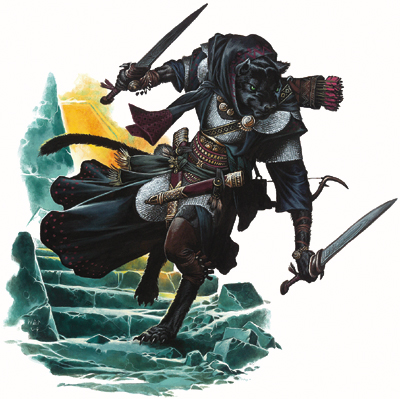
While some theorize that rakshasas are the very embodiment of evil, those rare few who have survived an encounter with the deadly naztharune know it as fact. Like other rakshasas, the palms of a naztharune rakshasa's hands are where the backs of the hands would be on a human. While this physical feature doesn't detract from the creature's manual dexterity, it makes a rakshasa look very disturbing to those unfamiliar with the creature.
Naztharune rakshasas, like most rakshasas, tend to be solitary creatures but will work with other rakshasas when necessary and even team up with other naztharunes on a continuing basis. They sometimes work as infiltrators and spies for ak'chazar rakshasas, and they sometimes hire themselves out to other creatures as mercenaries or assassins.
Naztharune rakshasas have a hearty contempt for all creatures except other rakshasas, but they can suppress this feeling when it profits them to do so. Unlike most of their rakshasa brethren, naztharune rakshasas feel less of a need to be "the boss" in every operation. They are much more mercenary in their desires and needs.
Unlike their spellcasting cousins, a naztharune rakshasa enjoys sneaking up on a target and killing it in close combat. Whenever possible, it uses allies to distract opponents and maneuver into flanking situations.
A naztharune rakshasa is about the same height and weight as an elf (5 feet tall, 100 pounds). Its body is mostly human except for a luxurious coat of black fur and its black, tigerlike head.
NAZTHARUNE RAKSHASA RACIAL TRAITS
-
+4 Strength, +10 Dexterity, +8 Constitution, +4 Intelligence, +4 Charisma.
-
Medium size.
-
A naztharune rakshasa's base land speed is 40 feet.
-
Darkvision out to 60 feet.
-
Racial Hit Dice: A naztharune rakshasa begins with eleven levels of outsider, which provide 11d8 Hit Dice, a base attack bonus of +11, and base saving throw bonuses of Fort +7, Ref +7, and Will +7.
-
Racial Skills: A naztharune rakshasa's outsider levels give it skill points equal to 14 × (8 + Int modifier). Its class skills are Balance, Bluff, Disguise, Escape Artist, Hide, Listen, Move Silently, Search, Spot, and Tumble. A naztharune has a +4 racial bonus on Bluff checks and Disguise checks, and it can gain further bonuses by using change shape (+10 on Disguise checks) and detect thoughts (+4 on Bluff and Disguise checks).
-
Racial Feats: A naztharune rakshasa's outsider levels give it four feats.
-
+5 natural armor bonus.
-
Natural Weapons: 2 claws (1d4).
-
Detect Thoughts (Su): A naztharune rakshasa can continuously use detect thoughts as the spell (caster level 18th; Will save negates, DC is 15 + the character's Cha modifier.). It can suppress or resume this ability as a free action. The save DC is Charisma-based.
-
Sneak Attack (Ex): If a naztharune rakshasa can catch an opponent when he is unable to defend himself effectively from its attack, it can strike a vital spot for extra damage. Basically, the naztharune rakshasa's attack deals extra damage any time its target would be denied a Dexterity bonus to AC (whether the target actually has a Dexterity bonus or not), or when the naztharune rakshasa flanks its target. The naztharune rakshasa's sneak attack ability is equivalent to that of a rogue of a level equal to the creature's Hit Dice. Should the naztharune rakshasa score a critical hit with a sneak attack, this extra damage is not multiplied.
-
Change Shape (Su): A naztharune rakshasa can assume any humanoid form, or revert to its own form, as a standard action. In humanoid form, a naztharune loses its claw attacks (although it usually uses weapons and armor). A naztharune rakshasa typically remains in one form until it chooses to assume a new one. A change in form cannot be dispelled, but a naztharune reverts to its natural form when killed. A true seeing spell reveals its natural form.
-
Improved Evasion (Ex): This ability works like evasion, except that while a naztharune rakshasa still takes no damage on a successful Reflex save against spells such as a fireball or a breath weapon, it now takes only half damage on a failed save.
-
Hide in Plain Sight (Su): A naztharune rakshasa can use the Hide skill even while being observed. As long as it is within 10 feet of some sort of shadow, a naztharune rakshasa can hide itself from view in the open without anything to actually hide behind. It cannot, however, hide in its own shadow.
-
Uncanny Dodge (Ex): A naztharune rakshasa can react to danger before its senses would normally allow it to do so. It retains its Dexterity bonus to AC even when caught flat-footed.
-
Improved Uncanny Dodge (Ex): A naztharune rakshasa cannot be flanked except by a rogue of at least 15th level.
-
Shadow Jump (Su): A naztharune rakshasa has the ability to travel between shadows as if by means of a dimension door spell. The limitation is that the magical transport must begin and end in an area with at least some shadow. A naztharune can jump up to 20 feet each day in this way; this can be a single jump of 20 feet or two jumps of 10 feet each.
-
Damage reduction 15/good and piercing.
-
Spell resistance equal to 21 + class levels.
-
Automatic Languages: Com mon, Infernal. Bonus Languages: Sylvan, Undercommon.
-
Favored Class: Rogue. Naztharune rakshasas also automatically qualify for the assassin prestige class.
-
Level adjustment +5.
SHIFTERS
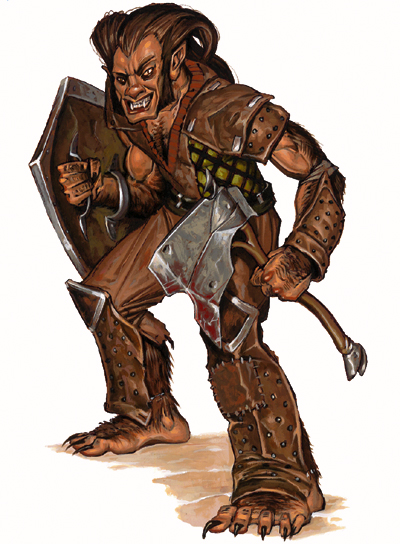
Shifters, sometimes called "the weretouched," are descended from humanoids and natural lycanthropes. Shifters cannot fully change shape but can take on animalistic features - a state they call shifting. Shifters have evolved into a unique race that breeds true. They have a distinct culture with its own traditions and identity.
Shifters' personalities are influenced by their animal natures. Many are boorish and crude, while others are quiet, shifty, and solitary. Just as most lycanthropes are carnivores, shifters have a predatory personality and think of most activities in terms of hunting and prey. They view life as a challenge, striving to be self-reliant, adaptable, and resourceful. Shifters are aggressive and feral in their approach to combat. When they feel superior to their opponents, they often stalk them like prey, remaining concealed until they can strike with surprise. They avoid stronger opponents but fight wildly if they are forced to.
Shifters generally live among humans, elves, or sylvan creatures, not in settlements of their own. They prefer rural or wilderness regions, though significant numbers of them live in the slums of human cities, often grouping together into criminal gangs. Many shifters earn their way as trappers, hunters, fishers, trackers, guides, and military scouts. Shifters usually congregate into family groups. These groups include about 30% noncombatants, primarily children.
A few elders govern the pack, under the leadership of a chief who is usually the pack's oldest member. Some shifters are loners, preferring the solitude of the wilderness to human society or even the company of their own kind. Most shifters are inclined toward druidic religion rather than the worship of a specific deity. They believe in the divine power of the earth itself, the elements, and the creatures of the earth.
SHIFTER RACIAL TRAITS
-
+2 Dexterity, -2 Intelligence, -2 Charisma.
-
Humanoid (Shapechanger).
-
Medium size.
-
Shifter base land speed is 30 feet.
-
Low-light vision.
-
Shifting (Su): A shifter can tap into his lycanthropic heritage to gain short bursts of physical power. Once per day, a shifter can enter a state that is superficially similar to a barbarian's rage. Each shifter has one shifter trait - a characteristic that manifests when he is shifting. Each shifter trait provides a +2 bonus to a physical ability score (Strength, Dexterity, or Constitution) and grants some other advantage as well.
Shifting is a free action and lasts for a number of rounds equal to 3 + the shifter's Con modifier. (If a shifter trait or other effect increases the shifter's Con modifier, use the newly improved modifier.) A shifter can take feats to improve this ability. Every shifter feat a shifter takes increases the duration of shifting by 1 round. For every two shifter feats a shifter takes, the number of times per day he can tap into the ability increases by one. So, a shifter with two shifter feats can shift two times per day (instead of the usual one), and each use of the ability lasts for a number of rounds equal to 5 (instead of 3) + the shifter's Con modifier.
Shifting, though related to and developed from lycanthropy, is neither an affliction nor a curse. It is not passed on by bite or claw attacks, and a shifter can't be cured - shifting is a natural ability for the race.
-
+2 racial bonus on Balance, Climb, and Jump checks.
-
Automatic Languages: Common. Bonus Languages: Elven, Gnome, Halfling and Sylvan.
-
Favored Class: Ranger.
CRYSTALLINE TROLLS
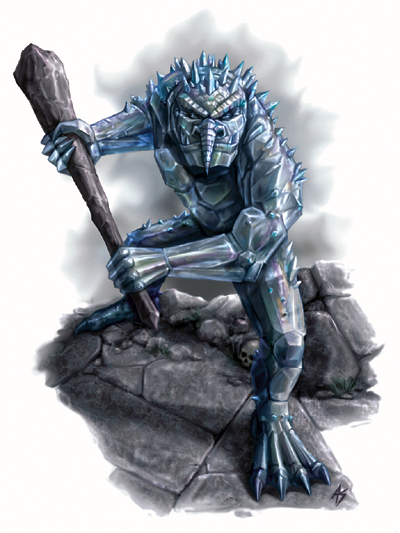
More charismatic than an ordinary troll, a crystalline troll is still only slightly less feral. A crystalline troll's skin is made of a glasslike material, making the creature look like a troll covered in rock crystal.
Like an ordinary troll, a crystalline troll has no fear of death and joins combat with vigor and pleasure. It attacks the nearest opponent. Even when being hurt with sonic attacks, the troll will continue its assault.
Crystalline trolls stand more upright than ordinary trolls. An adult is 11 feet tall and weighs 600 pounds.
CRYSTALLINE TROLL RACIAL TRAITS
-
+12 Strength, +4 Dexterity, +12 Constitution, -4 Intelligence (minimum 3), -2 Wisdom, -2 Charisma.
-
Large size. -1 penalty to Armor Class, -1 penalty on attack rolls, -4 penalty on Hide checks, +4 bonus on grapple checks, lifting and carrying limits double those of Medium characters.
-
Space/Reach: 10 ft./10 ft.
-
A crystalline troll's base land speed is 30 feet.
-
Darkvision out to 60 feet and low-light vision.
-
Racial Hit Dice: A crystalline troll begins with ten levels of giant, which provide 10d8 Hit Dice, a base attack bonus of +7, and base saving throw bonuses of Fort +7, Ref +3, and Will +3.
-
Racial Skills: A crystalline troll's giant levels give it skill points equal to 13 × (2 + Int modifier, minimum 1). Its class skills are Listen and Spot.
-
Racial Feats: A crystalline troll's giant levels give it four feats.
-
+7 natural armor bonus.
-
Natural Weapons: 2 claws (1d6) and bite (1d6).
-
Rend (Ex): If a crystalline troll hits with both claw attacks, it latches onto the opponent's body and tears the flesh. This attack automatically deals an additional 2d6 + Str modifier × 1-1/2 points of damage.
-
Scent.
-
Regeneration 5 (Ex): Sonic attacks deal normal damage to a crystalline troll. If a crystalline troll loses a limb or body part, the lost portion regrows in 3d6 minutes. The creature can reattach the severed member instantly by holding it to the stump.
-
Immunity to acid.
-
Vulnerability to sonic.
-
Automatic Languages: Giant. Bonus Languages: Common, Orc.
-
Favored Class: Fighter.
-
Level adjustment +5.
WARFORGED
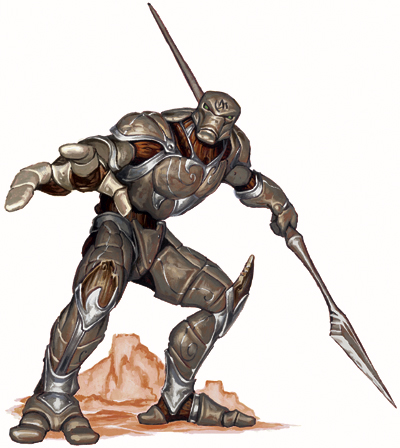
Warforged appear as massive humanoids molded from a composite of materials - obsidian, iron, stone, darkwood, and silver - though they move with surprising grace and flexibility. Flexible plates connected with fibrous bundles make up the body of a warforged, topped by a mostly featureless head.
Warforged have no physical distinction of gender, and all warforged have a body shape that is basically male. In personality, some warforged seem more masculine or feminine, but different people might judge the same warforged in different ways. The warforged themselves seem wholly unconcerned with matters of gender. The warforged do not age naturally, though their bodies do decay slowly even as their minds improve through learning and experience.
Warforged are able to modify their bodies through magic. Many warforged are adorned with heavier metal plates than those their creator originally provided, builtin weaponry, and other enhancements to their physical form, which helps to differentiate one warforged from another.
Warforged are built for combat, and they carry out that task admirably. Though they are capable of emotion, few warforged allow it to cloud the business of war. They fight efficiently and brutally, while remaining remarkably calm in the heat of battle.
A warforged stands between 6 and 6-1/2 feet tall and weighs about 300 pounds.
WARFORGED RACIAL TRAITS
-
+2 Constitution, -2 Wisdom, -2 Charisma.
-
Living Construct Traits (Ex): As living constructs, warforged possess a number of racial traits.
-
Medium size.
-
Warforged base land speed is 30 feet.
-
Composite Plating (Ex): The plating used to build a warforged provides a +2 armor bonus. This plating is not natural armor and does not stack with other effects that give an armor bonus (other than natural armor). This composite plating occupies the same space on the body as a suit of armor or a robe, and thus a warforged cannot wear armor or magic robes. A warforged can be enchanted just as armor can be. The creature must be present for the entire time it takes to enchant him.
Composite plating also provides a warforged with a 5% arcane spell failure chance, similar to the penalty for wearing light armor. Any class ability that allows a warforged to ignore the arcane spell failure chance for light armor lets him ignore this penalty as well.
-
Light Fortification (Ex): When a critical hit or sneak attack is scored on a warforged, there is a 25% chance that the critical hit or sneak attack is negated and damage is instead rolled normally.
-
Automatic Language: Common. Bonus Languages: None.
-
Favored Class: Fighter.
WARFORGED CHARGERS
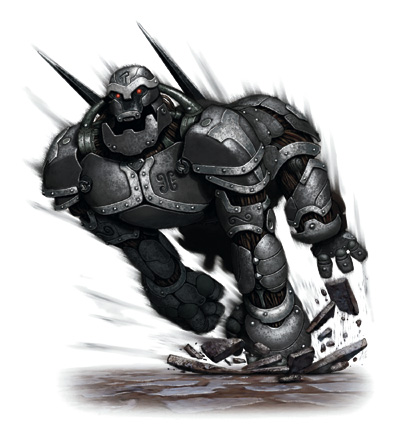
An earlier model of warforged than the scouts and soldiers, chargers are larger, less intelligent, and generally less adaptable than their successors. They are designed for a single task: charging enemy defenses and pounding them to rubble.
Warforged chargers demonstrate less strategy and initiative than smaller warforged, clinging to their simple orders or, barring that, smashing anything that gets in their way.
A warforged charger stands 10 to 11 feet tall and weighs up to 2,400 pounds.
WARFORGED CHARGER RACIAL TRAITS
-
+10 Strength, +10 Constitution, -6 Intelligence, -4 Wisdom, -8 Charisma.
-
Living Construct Traits (Ex): As living constructs, warforged possess a number of racial traits.
-
Large size. -1 penalty to Armor Class, -1 penalty on attack rolls, -4 penalty on Hide checks, +4 bonus on grapple checks, lifting and carrying limits double those of Medium characters.
-
Space/Reach: 10 ft./10 ft.
-
A warforged charger's base land speed is 30 feet, but this is reduced to 20 feet by its Adamantine Body bonus feat.
-
Racial Hit Dice: A warforged charger begins with four levels of construct, which provide 4d10 Hit Dice, a base attack bonus of +3, and base saving throw bonuses of Fort +1, Ref +1, and Will +1.
-
Racial Skills: A warforged charger's construct levels give it skill points equal to 7 × (2 + Int modifier, minimum 1). Its class skill is Jump.
-
Racial Feats: A warforged charger's construct levels give it two feats. It also receives Adamantine Body and Powerful Charge as bonus feats.
-
Natural Weapons: 2 slams (1d8).
-
Adamantine Fists (Ex): A warforged charger's hammerlike fists are forged of adamantine, allowing it to overcome the damage reduction of other constructs and to ignore the hardness of objects.
-
Adamantine Plating (Ex): The composite plating used to build most warforged is enhanced to adamantine in the warforged charger (reflected in the Adamantine Body feat), providing a +8 armor bonus and granting damage reduction 2/adamantine. This plating is not natural armor and does not stack with other effects that give an armor bonus (other than natural armor). This plating occupies the same space on the body as a suit of armor or a robe, and thus a warforged charger cannot wear armor or magic robes. A warforged charger can be enchanted just as armor can be. The creature must be present for the entire time it takes to enchant it.
Adamantine plating also provides a warforged charger with a 35% arcane spell failure chance. A charger is considered to be wearing heavy armor that allows a maximum Dexterity bonus of +1 and provides a -5 armor check penalty.
-
Moderate Fortification (Ex): When a critical hit or sneak attack is scored on a warforged charger, there is a 75% chance that the critical hit or sneak attack is negated and damage is instead rolled normally.
-
Automatic Language: Common. Bonus Languages: None.
-
Favored Class: Fighter.
-
Level adjustment +4.
WARFORGED SCOUTS
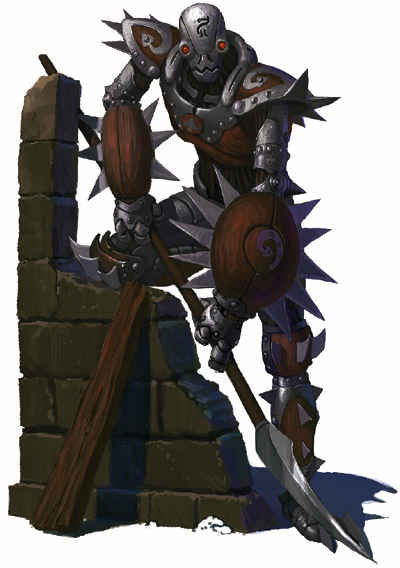
The smallest of the warforged, the halfling-sized scouts were built to serve as spies, light infantry, and reconnaissance troops. They are far less common than the larger varieties, since they offer little advantage over humanoid scouts in warfare.
Warforged scouts avoid face-to-face melee, preferring to pepper opponents with arrows from cover and then disappear before striking again.
A warforged scout stands about 3 feet tall and weighs 60 pounds
WARFORGED SCOUT RACIAL TRAITS
-
+2 Dexterity, -2 Strength, -2 Wisdom, -2 Charisma.
-
Living Construct Traits (Ex): As living constructs, warforged possess a number of racial traits.
-
Small size. +1 bonus to Armor Class, +1 bonus on attack rolls, +4 bonus on Hide checks, -4 penalty on grapple checks, lifting and carrying limits 3/4 those of Medium characters.
-
A warforged scout's base land speed is 20 feet.
-
Composite Plating (Ex): The composite plating used to build warforged scouts provides a +2 armor bonus. This plating is not natural armor and does not stack with other effects that give an armor bonus (other than natural armor). This composite plating occupies the same space on the body as a suit of armor or a robe, and thus a warforged scout cannot wear armor or magic robes. A warforged scout can be enchanted just as armor can be. The creature must be present for the entire time it takes to enchant him.
Composite plating also provides a warforged scout with a 5% arcane spell failure chance, similar to the penalty for wearing light armor. Any class ability that allows a warforged scout to ignore the arcane spell failure chance for light armor lets him ignore this penalty as well.
-
Light Fortification (Ex): When a critical hit or sneak attack is scored on a warforged scout, there is a 25% chance that the critical hit or sneak attack is negated and damage is instead rolled normally.
-
Automatic Languages: Common. Bonus Languages: None.
-
Favored Class: Rogue.
WITCHKNIVES
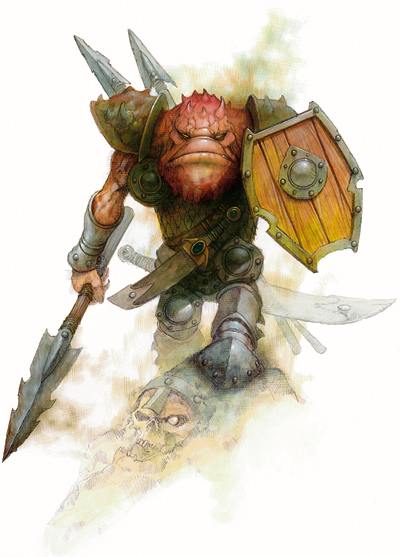
"Witchknife" is the name other creatures use to refer to a race of humanoids that have the power to compel victims to do their bidding with but a single utterance. This power, and their tendency to stab foes in the back, are the reasons behind the name.
These creatures call themselves athames. Witchknives live in small settlements, hiding in deserts and other forbidding locations, while they plot to regain from the world what they believe they once had.
One athame legend tells of a time when all creatures spoke one language and athames ruled the world. Their word was law, and other creatures obeyed any command the athames gave. Then a deity interfered and taught the athames' subjects to speak new languages. This broke the athames' power over them, and the subjects, who feared and hated the athames despite their magnanimous rule, rebelled and tore the athame empire to pieces. This legend can be refuted in many ways, one of which is that different athame settlements blame different deities for their downfall, but nonetheless all athames believe the legend with a religious fervor.
This much of the athames' legend is true: Other races do fear and hate the witchknives. The power of the witchknives to control creatures with a word drives other races to desperate actions in order to oppose them. Elves have allied with orcs, and giants with dwarves, in efforts to root out and destroy witchknife settlements.
Witchknives live in small enclaves that rarely have more than two hundred adults, hidden from the civilizations of other races. These enclaves have a hierarchy of rank determined by birth, but most witchknives are of equal rank and have many rights and privileges. Witchknives do not use their psionic abilities on witchknives of equal or higher rank except in training exercises.
Witchknives live in an austere and monastic manner inside their fortresslike homes. Those not involved in the tasks of day-to-day survival and subsistence spend most of their time meditating, training for combat, or learning at the library.
Witchknives use their silence psionic ability to protect themselves from sonic attacks and aid their attempts to stalk enemies. When within striking distance of a foe unaware of its presence, a witchknife attacks from hiding. Multiple witchknives attempt to flank foes.
If confronting many foes, a witchknife uses its greater command ability to have them fall prone. It then attempts to kill each foe in turn, using its command ability to delay any foe that succeeds in withstanding its greater command. If facing a spellcaster, a witchknife often dismisses its silence ability long enough to utter a greater command and then renews it to engage the spellcaster in melee.
Witchknives have tough skin that ranges in color from dark brown to ruddy orange. They have short red horns in the places where other creatures have hair. Their eyes are orange or yellow with red pupils. A typical witchknife stands 5 feet tall and weighs 120 pounds.
A witchknife's psionic ability to command others relies on the target creatures being able to understand the witchknife. Thus, witchknives learn to speak many languages. All of them speak Common and Undercommon, and most know four other languages. Typical choices include Dwarven, Elven, Giant, and Goblin.
Most witchknife clerics worship Mnemeer, the Great Mediator, as the source of their psionics. They can choose from the Knowledge, Magic, and Trickery domains.
WITCHKNIFE RACIAL TRAITS
-
+6 Dexterity, -2 Constitution, +2 Intelligence, +4 Wisdom, +6 Charisma.
-
Medium size.
-
A witchknife's base land speed is 30 feet.
-
Low-light vision.
-
Racial Hit Dice: A witchknife begins with nine levels of monstrous humanoid, which provide 9d8 Hit Dice, a base attack bonus of +9, and base saving throw bonuses of Fort +3, Ref +6, and Will +6.
-
Racial Skills: A witchknife's monstrous humanoid levels give it skill points equal to 12 × (2 + Int modifier, minimum 1). Its class skills are Concentration, Hide, Sense Motive, Speak Language, and Spot.
-
Racial Feats: A witchknife's monstrous humanoid levels give it four feats.
-
Weapon and Armor Proficiency: A witchknife is automatically proficient with all simple weapons, light armor, and shields (except tower shields).
-
+1 natural armor bonus.
-
Psionics (Sp): At will - command, message, silence (self only; dismiss as a free action); 1/day - greater command. Caster level 9th. The save DCs are Charisma-based.
-
Sneak Attack (Ex): A witchknife can make a sneak attack like a rogue, dealing an extra 2d6 points of damage whenever a foe is denied its Dexterity bonus or when the witchknife is flanking.
-
Resistance to fire 5.
-
Vulnerability to sonic.
-
Automatic Languages: Common, Undercommon. Bonus Languages: Any except secret languages such as Druidic.
-
Favored Class: Rogue.
-
Level adjustment +3.